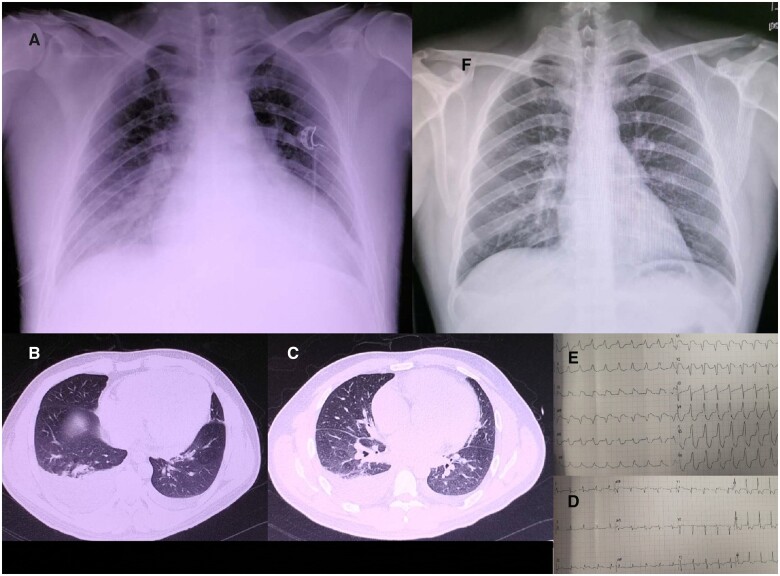A 37-year-old male patient was admitted to hospital on 14 January 2020, with chest pain and dyspnoea for 3 days, accompanied by diarrhoea. His blood pressure decreased to 80/50 mmHg. X-ray chest film showed significant enlargement of the heart (Panel A: cardiothoracic ratio 0.70). Chest computed tomography (CT) examination indicated pulmonary infection, enlarged heart, and pleural effusion (Panels B and C). The electrocardiogram suspected ST-segment elevation acute myocardial infarction (III, AVF ST-segment elevation, Panels D and E), an emergency CT coronary angiography revealed no coronary stenosis. Markers of myocardial injury were significantly elevated. Troponin T was more than 10 000 ng/L. Creatine kinase isoenzyme CKMB 112.9 ng/L. Natriuretic peptide BNP was up to 21 025 ng/L. Echocardiography revealed an enlarged heart and a marked decrease in ventricular systolic function [left ventricle (end diastolic) dimension (LV) 58 mm, left atrium dimension (LA) 39 mm, right ventricle dimension (RV) 25 mm, right atrium dimension (RA) 48 mm, left ventricular ejection fraction (LVEF) 27%, trace 2 mm pericardial effusion]. Sputum was examined for 13 viral nucleic acids related to respiratory tract. Only the coronavirus nucleic acid test was positive. All of the other 12 nucleic acid tests were negative, including influenza A virus, adenovirus, bocavirus, rhinovirus, influenza A(H1N1) 2009, parainfluenza, chlamydia, partial pulmonary virus, influenza B virus, mycoplasma pneumoniae, influenza A virus H3N2, and respiratory syncytial virus. The diagnosis of this patient is coronavirus fulminant myocarditis with cardiogenic shock and pulmonary infection.
Treatments include methylprednisolone to suppress inflammation (200 mg/day, 4 days), and immunoglobulin to regulate immune status (20 g/day, 4 days), norepinephrine to raise blood pressure, diuretic (toracemide and furosemide) to reduce cardiac load, milrinone to increase myocardial contractility, piperacillin sulbactam for anti-infection, pantoprazole, to inhibit gastric acid. After treatment, the patient’s symptoms improved significantly. One week later, X-ray chest film showed heart size normal (Panel F cardiothoracic ratio 0.49). Echocardiography showed that the size and function of the heart had returned to normal (LV 42 mm, LA 34 mm, RV 24 mm, RA 33 mm, LVEF 66%). Markers of myocardial injury dropped significantly after 1 week of treatment. Troponin T was 220.5 ng/L. Creatine kinase isoenzyme CKMB 9.14 ng/L. Natriuretic peptide BNP was 1587 ng/L. After 3 weeks, the myocardial injury markers had fully recovered to the normal range. Troponin T was 21.4 ng/L. Creatine kinase isoenzyme CKMB was 2.25 ng/L. Natriuretic peptide BNP was 139 ng/L.
Unlike other coronavirus infections, which mainly cause pulmonary infections, this case of coronavirus infection was characterized by heart damage. The cardiac chamber dimensions increased in a short period of time and quickly returned to normal after treatment. This case report is helpful in treating other similar patients. It is suggested that early glucocorticoid anti-inflammatory therapy and immunoglobulin therapy may be of important value to this type of patient.
National Key Research and Development Program of China (Award number: 2017YFC1307800).
Contributor Information
Hongde Hu, Department of Cardiology, West China Hospital, Sichuan University, 37 Guoxue Alley, Chengdu, 610041, PR China.
Fenglian Ma, The Postgraduation Training Department of West China Hospital, Sichuan University, 37 Guoxue Alley, Chengdu 610041, PR China.
Xin Wei, Department of Cardiology, West China Hospital, Sichuan University, 37 Guoxue Alley, Chengdu, 610041, PR China.
Yuan Fang, Department of Cardiology, West China Hospital, Sichuan University, 37 Guoxue Alley, Chengdu, 610041, PR China.



